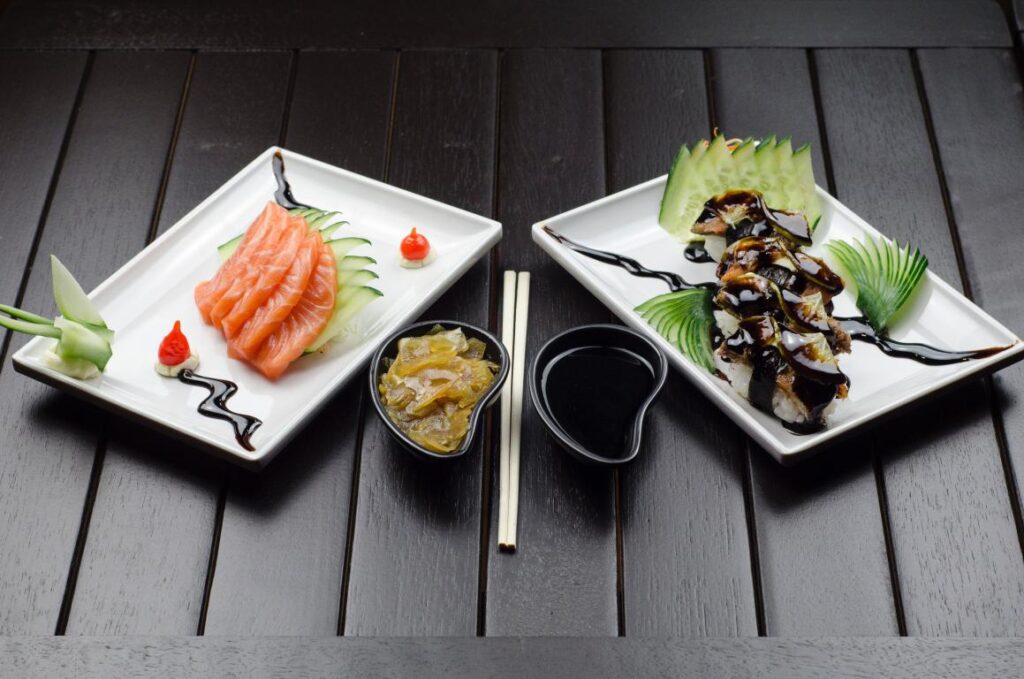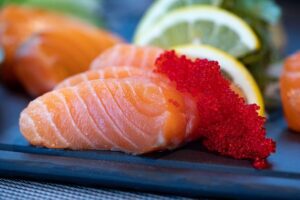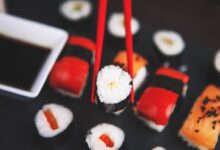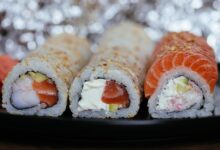
best Sushi–The Japanese Delicacy
Sushi is a Japanese dish, popular all throughout the world. Sushi lovers, young and old alike,
mistakenly think Sushi refers to raw sea fish. Sushi actually means vinegar-flavored rice and the raw food accompanying it are called Sashimi.
Types of Sushi Preparations
There are five kinds of Sushi preparations like Nigiri, Maki, Temaki, Chirashi and Inari Sushis. Sushi rice is the staple ingredient in all of them.
The types are determined by the kind of fillings or toppings used. The same ingredients can be served, assembled in both traditional and modern ways.
-Nigiri Sushi is the most popular form of Sushi. It is served with an oblong mound of rice topped by wasabi and a thin slice of egg, seafood or any meat. While the egg is always served cooked, the seafood and the meat may be raw.
-Maki Sushi is served rolled in nori, which is a kind of pressed seaweed. The rice, seaweed and the toppings are rolled into a cylindrical shape using a bamboo mat.
The roll is then sliced into various thick and thin pieces. The California and Boston rolls are examples of this Sushi.
-Temaki Sushi is similar to Maki except that it is hand rolled into a cone and is not chopped into small pieces.
-Chirashi Sushi: A rare Sushi, it consists of a bowl of rice with toppings of Sashimi or raw seafood or fish.
-Inari Sushi: Rare than even Chirashi are served as fried pouches of tofu stuffed with rice.
Ingredients for cooking up the best Sushi preparations
Rice: All Sushi preparations use short – grained Japonica rice mixed with a dressing of rice vinegar, sugar, salt, kombu and sake. The right stickiness is its essential quality.
Nori: These are wrappers made from sea weed, a type found in Japan. It is toasted before use. Nori by itself is edible. There are many kinds of ‘nori’ but the best quality is used in Sushi.
Toppings used in Sushi
Fish: For culinary, sanitary and aesthetic reasons the fish eaten raw must be fresher and of higher quality than fish which is cooked. In fact, professionals are employed to select the fish. Fish served raw are sea fish like tuna, mackerel and salmon.
Fresh water fishes are cooked and never eaten raw since they are likely to contain parasites. The most valued Sushi ingredient is “toro”, the fatty cut of tuna. Toro comes in many qualities.
Sea food: Squid, octopus, shrimp and various shell fishes are used for sea food.
Vegetables: Pickled Daikon radish, pickled vegetables, fermented soya beans, asparagus, yam, tofu and gourd are some of the topping vegetables.
Red meat: Beef, ham, sausage and horse meat, often lightly cooked, are used for toppings.
Eggs: Slightly sweet layered omelettes and raw quail eggs are used as toppings.
Condiments used for preparing Sushi
The three main condiments are:
– shoyu which is soy sauce
– “wasabi” which is the grated root of the “wasabi” plant. Real “wasabi”, called “hon-wasabi” has anti-bacterial property which prevents food poisoning.
– “gari” which is sweet pickled ginger, cleanses the palette and aids in digestion.
Presentation is most important
Traditionally Sushi is served in an austere style in single or double tone colored plates. In smaller Japanese restaurants, plates are dispensed with,
and the dish is had straight from the wooden counter. However in many places, particularly in U.S., a European sensibility has been imparted in to Sushi serving, resembling French cuisine.
Do You Like Sushi?
If you are not the biggest fan about sushi, you are not the only one. What I do not understand is why people say they do not like sushi when they have not even tried it before.

As with most foods, there are several variations and different ways to cook it. All it takes is a little bit of courage to try out the different variations and who knows, you may find something that you like.
Sushi is one of the best nutritional sources available to us, which may be one reason people are turned off by it. There are some people that have it in their head that all health food is going to taste bad.
Others may be turned off by the fact that it is seafood. But sushi is packed with lean protein, nutrients, and is low in fat.
A couple of other healthy parts to sushi are the seaweed wrap, wasabi and ginger. The seaweed wrap, which is called nori, is rich with vitamins and minerals that get lost with many other kinds of foods.
As for wasabi and ginger, they contain antibacterial qualities and ginger also aids digestion and improves circulation.
By now you get the point that sushi is good for you, but that does not make it appetizing to everyone. However, there are hundreds of recipes for making sushi that many people are unwilling to learn about.
There is the basic hand rolled sushi and vegetable hand rolled sushi, but there are several ways to get unique while making sushi.
One fantastic recipe worth trying out is smoked salmon and jicama maki sushi rolls. While the recipe is not complex at all, I recommend going to www.foodnetwork.com to find the exact recipe.
But some of the items that are in the recipe include sushi rice, smoked salmon strips, jicama strips, and eight sheets of nori. When you are finished making it, you will have delicious rolls filled with flavor and packed with nutrition.
If you are not a big fish fan, try out somen sushi noodle with wasabi oil and soy syrup. This is a little more complex to make, but worth it when it is cooked. As with the recommendation above, you can find the recipe at the food network online.
Some of the main ingredients you will find with this dish are a half pound of somen noodles, chopped scallions, soy sauce, rice wine vinegar, and wasabi oil.
Not everyone is going to be a big fan of sushi, and there are plenty of people that probably hate it. But try to muster up the courage to try the different variations and recipes out there, because it can be one of the better kinds of seafood you will try.
Just because it is seafood and healthy for you, it does not mean you will not like sushi. So give it a chance.
Cut the JUNK fats with Sushi
You’ve heard the popular advice on weight loss diets. Cut the fat! Cut the carbs! Cut the calories! Eat a balanced diet! Yes it’s true.

But it’s confusing. So many people fail because of “information overload”.
How can you eat a diet that’s balanced and healthy in order to cut fats, carbs and calories?
Here’s the advice from nutritional science:
Cut the JUNK fats: Most people do not need an ultra low fat diet. But most of us could improve our diet by cutting out the junk fats.
Basically, these are the processed fats: hydrogenated fats, polyunsaturated oils that have been heated, and fats that are combined with junk carbs. Processed fats are the fats most likely to put on flab and clog your arteries.
Cut the JUNK carbs. Most people do not need an ultra low carb diet. But unfortunately, so many people who go on a low fat diet continue to eat highly processed foods – they switch from processed high-fat to processed low-fat.
And when food manufacturers create low fat foods, they tend to replace the fat with junk carbs, which tend to pile on the pounds. Basically, junk carbs are low-fiber carbs, like sugar, fructose (and all the other *oses), flour, cornstarch, fruit juice.
Yes, fruit juice is a junk carb too! – After all, how much fiber is there in fruit juice? – Virtually none – it’s yet another junk carb. You should eat the whole fruit instead, with its fiber intact.
Cut the JUNK calories. Most people do not need an ultra low calorie diet. But just think what your diet would be like if you dropped the processed fats and the low-fiber carbs.
You’d be eating mainly natural proteins, with lots of vegetables plus whole fruits – and the odds are that you would be eating far fewer calories as well. That’s the kind of calorie cutting most of us should be doing.
Eat a balanced NATURAL-FOODS diet. By natural foods, we mean the foods that would have been eaten by your hunter-gatherer ancestors: –
lots of whole vegetable foods for vitamins and fiber; moderate to small portions of meats, fish, seafood, and other animal and protein foods, grilled, stewed or baked; and small portions of fresh whole fruit in season.
This is the diet on which the human race evolved, and the diet which, for the vast majority of people, makes for optimum health
So the next time you’re about to order a meal with fries and sugary soda, think about how it could be improved.
Replace the fries with a salad, and the soda with mineral water, and you’ve already made significant progress towards a healthier, balanced meal.
And at home, look for recipes that use whole, fresh foods, with a minimum of processing. Make sure your meals include natural unprocessed foods,
with lots of healthy vegetables, both cooked, and raw in salads. Avoid processed fats and processed low-fiber foods.
A sample menu:
– grilled fish with steamed green beans, and peppers
– mixed salad, dressed with small amounts of olive oil and vinegar or lemon juice
– fresh fruit platter
– Sushi : fish and seafood (low-fat and well balanced in terms of nutrition)
– Tofu (bean curd): low-fat, quality protein food. Highly recommended
I personally recommend Sushi for your healthy weight-loss. Cheap junk food is OK(I actually like junk food too). But don’t eat junk food too much for health!
Would you like to try sushi? Sushi is very healthy.
With the rise in popularity of sushi in western countries you may be invited by friends to join them at the local sushi bar.
Many of Hollywood celebrities love to eat Sushi in fact. While you may be anxious about the prospect of eating anything raw,
don’t worry, all you need is a little bit of information to take the anxiety away from the experience and enjoy this wonderful delicacy.
Sushi is a very simple dish, although the making of it is considered an art form. The Itamae (sushi chef) traditionally needs to train for 10 years before being hired to prepare sushi. However, the popularity of sushi has forced the hiring of chefs with only a few years experience.
There are four main types of sushi you can order:
Nigiri sushi: nigiri means “grab”. These are hand pressed balls of rice with raw fish on top and bit of wasabi between the fish and rice.
Sashimi: sliced raw fish (technically not sushi since the term sushi refers to the rice and sashimi is not prepared with any rice).
Maki sushi: maki means “roll”. The maki sushi is rolled with bamboo mats. Traditionally the seaweed is on the outside; rice on the outside is called ‘inside-out’ (ie: California roll).
Temaki is a hand rolled version of Maki. It is cone shaped like an ice cream cone.
Sushi comes in an amazing variety of combinations, however you’ll find these common ingredients or garnishes with nearly every version:
The word sushi actually refers to The rice, also called ‘sticky rice’. Sushi rice is short grained and cooked with a 1:1 ratio of water. Sushi vinegar and sugar is added which makes the rice both sweet and tart.
Wasabi: Japanese horseradish. Often served as a green paste alongside your sushi as an additional condiment; a word of caution – wasabi is VERY hot, so use it sparingly while developing a taste for it.
Gari: Thinly sliced, pickled ginger is also served with sushi. Some use it as a garnish although it is technically to refresh your palette between bites.
Nori: The seaweed sheets used to roll rice for sushi.
Soya Sauce (Shoyu): used as a dipping sauce. The wasabi can also be mixed with the soya sauce for those who enjoy the intense flavor.
Sushi can be made with a single ingredient or several. Single ingredients include avocado, cucumber (kappa), tuna (tekka or maguro) or salmon (sake ? but not the rice wine). There are also many modernized combinations designed to please American palettes.
These include the California roll made with avocado, crab, and cucumber and the Philadelphia roll made with smoked salmon, cream cheese, and cucumber.
As you can see, despite the unusual presentation you can easily find identifiable and delicious combinations you are sure to enjoy.
Despite what you may think, the nori (seaweed) has very little flavor and is nearly undetectable when combined with the flavors of the sushi and the addition of soya sauce or wasabi. In fact, like many other converts, you may just have found yourself a new addiction!
Yes – A healthy, balanced diet can be that simple!
Lose Weight: Sushi Is Your Friend
If you’re not making sushi at home you’re missing out on a delicious and extremely diet-friendly meal. It’s easy to make, fast, nutritious, and the raw fish you’re afraid of is completely optional.

First let’s have a brief overview of sushi for those who’ve never had it or those who have tried it but want to know more.
Sushi is the catch-all name for a wide variety of Japanese dishes. The word sushi actually refers to rice with rice vinegar added.
Since this is a very basic and lightly flavored food, it is the many ingredients added to it that really define what dish you are eating.
The raw fish you have heard of is sashimi – an ingredient of many types of sushi – but you can create sushi with virtually any ingredient that goes with rice.
In America by far the most common type of sushi is Maki-sushi, or rice wrapped in seaweed. The seaweed is called nori and forms the green skin you can see around sushi pieces.
For this reason maki-sushi are called nori rolls on many menus. Also popular is Nigiri-sushi, small bars of rice topped with wasabi and sashimi.
It’s easy to include sushi into a healthy diet. Think of the ingredients: rice, vegetables, and fish. Not exactly a heart-attack in the making, just the opposite in fact.
As long as you don’t go overboard on the rice it is extremely low calorie in addition to being low fat. Where we chomp pork rinds and potato chips, the Japanese have sushi. Care to guess which country has a longer average life span?
Let’s learn how to make a California roll, easily the most popular nori roll in America today. You will need the following items, all of which should be easy to find in your supermarket’s oriental foods section or at your local Asian market:
Bamboo rolling mat
Sushi rice (short or medium grain)
Nori (squares of roasted seaweed)
Salt
Sugar
Rice vinegar
Imitation crab meat
Avocado
Cucumber
Wasabi
Soy sauce
Prepare the rice according to the directions on the package. You will need about 3/4 cup cooked rice for each sushi roll, and most people will be full after eating 1 or 2 rolls.
In a small pan, place a tablespoon of vinegar and 1/3 tbsp of sugar and salt for each 3/4 cup of rice you are cooking.
Heat the resulting mixture briefly and stir until the sugar dissolves. When the rice is almost done cooking, begin cutting your vegetables.
Peel a cucumber and cut it into long thin strips, about a 1/4″ around. Same for the avocado. If you bought powdered wasabi prepare it also (just mix in tiny amounts of water until you get a thick paste).
Once the rice is done, remove it from heat and slowly fold in the vinegar mixture. Then lay the rice out on a sheet of foil or a baking sheet and allow it to cool (traditionally this is done by fanning the rice while slowly stirring it).
The rice should be slightly damp and sticky, but not wet and mushy. Getting the rice right is the most difficult part of making sushi, but a little practice will teach you what works.
Once the vinegared rice has cooled off, you are ready to put it all together. Lay your bamboo rolling mat in front of you horizontally (the bamboo sticks should run left-right).
Take a sheet of nori and lay it on the rolling mat. Spread a layer of rice on the nori, covering about 3/4 of it. The part of the nori not covered in rice will hold the roll closed (think of the glue strip on an envelope or the gum on a cigarette paper).
Place a strip of avocado and a strip of cucumber on the rice, and top it with crab meat. Now wet your fingers with cold water and dampen the part of the nori you left uncovered.
Carefully roll the sushi using the mat, starting with the rice side and rolling it up (don’t roll the mat into it, silly).
If this sounds complicated, don’t worry. It is as simple as rolling up a sleeping bag or a beach towel, and it will be obvious to you once you actually have the ingredients in front of you.
Take the resulting roll and cut it into bite sized slices, usually 6 per roll. If you are having trouble cutting the roll without damaging it, try dipping your knife into water between each cut. Lay the pieces flat and they will look like little colorful discs. Serve with wasabi and soy sauce on the side.
If you feel brave and want to try sashimi, here are a few safety tips. First of all, understand that millions of people eat raw fish every day without getting sick.
However, most of them live right next to the sea where fresh fish is abundant. For many land-locked Americans this isn’t the case.
Fish that is prepared for shipping to a grocery store in Boise is not handled in the same way as that bound for a San Francisco sushi bar.
Look for fish that is specially labeled as sushi-grade. Avoid freshwater fish, with the notable exception of Salmon, which spends much of its life at sea.
When buying whole fish, make sure the gills are bright red and not slimy, the eyes should be transparent and not cloudy, and there should be no fishy odor.
Take up a healthy and nutritious sushi addiction today. It may take you a while to get the rice and the rolling right, but once you are experienced you’ll be able to whip out several nori rolls in five minutes.
best sushi restaurant in japan,best sushi in japan michelin,best sushi in japan tokyo,japanese food,sushi restaurant tokyo japan,best city in japan for sushi,best japanese restaurant in cairo,best Sushi–The Japanese Delicacy


